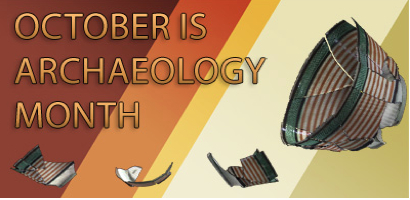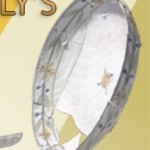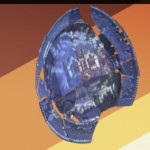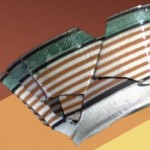The PECO Crown Lights ‘Archaeology Month’ Messages
Back to October 2013 Event…
Back to the October ‘Explore’ Event Home Page
Back to PAF Home
PSA Gallery 2013-2019

WHAT IS THIS MESSAGE ABOUT?
October is Pennsylvania Archaeology Month. To help make this more widely known, two 30-second public Service Announcements, or PSAs, have been created to run on the PECO Building’s Crown Lights marquee. One announces the ‘Explore Philly’s Hidden Past!’ archaeology event that this year (2014) takes place on Saturday October 4th. A second message celebrates the Governors designation of October as Pennsylvania Archaeology Month. (There are two versions of this latter message featuring 2 different objects.)
These PSAs are designed to generate awareness of archaeology among the broader community. The PSAs were created in 2011 at the request of the Philadelphia Archaeological Forum by students and faculty from Drexel University who also update the PSA annually (2012, 2013, 2014). Producing these messages leveraged local archaeological research and local computer science and media arts expertise.
WHAT’S THAT TWIRLING ON THE PECO BUILDING? (See it here…)
IT’S A PLATE! IT’S A BOWL!

The Archaeology Month messages features archaeological objects that were excavated from the city of Philadelphia:
This is a small, hand-painted, pearlware saucer manufactured sometime between 1780 and 1820. The plate was manufactured in England and was purchased in a shop somewhere likely here in Philadelphia. This dish would be typical middle class tableware in its day. Archaeologists discovered this item in Independence National Historical Park during the construction of the National Constitution Center.

This is a small plate with a blue transfer-printed decoration. This dish would likely have been part of a matched set of dishes. In the early 19th century this style of tableware was fashionable and somewhat pricey. Fragments of this dish were discovered in Independence National Historical Park during archaeological work done in advance of the construction of the National Constitution Center.

Archaeologists call bowls that are decorated with bands of color like this either ‘dipt’ or ‘annular ware’. This bowl may have been used both when preparing food and when eating or consuming food (most likely soups, stews, and or porridge). The type of decoration indicates to the archaeologist that this bowl is not an expensive item. It was discovered by archaeologists in Independence National Historical Park during the construction of the National Constitution Center. (This bowl and others like it from the same site were on display in 2011-2012 at Wintethur Museum. Learn more about that exhibit here.)
These three objects are just a few of the approximately 1 million artifacts discovered at the site of the National Constitution Center when that building was being built. These artifacts are evidence left behind by those who lived in Philadelphia during the early years of our nation. This archaeological evidence has many stories to tell us. All of these artifacts are taken care of for the American people by Independence National Historical Park.
HOW WERE THE PSA’s MADE?
The PSAs bring together science, art and technology. A 3D reconstruction of an artifacts found at the National Constitution Center archaeology site begins each of the PSAs. The artifacts were recovered by a team of archaeologists supervised by the National Park Service between 2000 and 2003. The 3D artifact reconstructions were created by Drexel University Computer Science Ph.D. student Geoff Oxholm. Oxholm has designed cutting edge software that virtually reconstructs historical artifacts. His work is part of a Drexel University-based, computational archaeology research project funded by the National Science Foundation: (Grant Award No. 0803670) The 3D Colonial Philadelphia Project — Digital Restoration of Thin-Shell Objects for Historical Archeological Research and Interpretation (2009-2012).
During the summer term of 2011, Drexel University undergraduate students Hannah Winograd and Mathew Hass, and Digital Media Masters student Mark Petrovitch, converted this scientific data to make it compatible with design software. Winograd and Haas animated the artifact reconstructions using Adobe Premier and joined them with the PSA text created using Adobe Photoshop. Haas and Winograd’s production was supported by Drexel University’s Pennoni Honor’s College Students Tracking Advanced Research (STAR) Fellowship Program and the Digital Media Program of the Antoinette Westphal College of Media Arts and Design. Their work was supervised by STAR mentors and NSF Co-Principle Investigators, Glen Muschio, Associate Professor, Animation and Visual Effects Program, and Visiting Research Professor Patrice Jeppson, Westphal College. Mr. Hass and Ms. Winograd worked in close association with Mr. Oxholm to produce the 30 second PSAs. Mr. Hass updated the event-dedicated PSA in 2011. Zachary Stockmal, a 2013 STAR student, did the same for the 2013 broadcast and STAR Scholar Matthew Mlodzienski has updated the message again for 2014. Brendan Luu made updates for their broadcasting in 2016.
PECO projects the PSA messages from a 40 foot high marquee of lights that encircles the top of the company’s headquarters building in downtown Philadelphia. This means the Archaeology Month message is 27 floors up in the sky! The messages run along side other messages from sundown to sunrise via 2 million LEDs, or light-emitting diodes. The messages make Philadelphia’s contribution to Pennsylvania Archaeology Month unique and special.
See later PSA write ups:
ACKNOWLEDGEMENTS
The Philadelphia Archaeological Forum thanks PECO for running these public service announcements in support of Pennsylvania Archaeology Month on their PECO Crown Lights system. A giant thank you goes out to Drexel University students and faculty for creating the animated Archaeology Month messages projected by the PECO Crown Lights system.
SEE THE MESSAGE running on the PECO marque here…
Learn more about…
Read a write up about this project at The Online Journal in Public Archaeology Volume 2 -2012 p. 55-80, “Public Archaeology via skyscraper: Outcome and Experience”, by Patrice L. JEPPSON (Philadelphia Archaeological Forum), Glen MUSCHIO (Drexel University. Digital Media Program, College of Media Arts and Design), Hannah WINOGRAD (Drexel University. STAR Fellowship Program, Pennoni Honors College Digital Media Program, College of Media Arts and Design), Matthew HAAS (Drexel University. STAR Fellowship Program, Pennoni Honors College Digital Media Program, College of Media Arts and Design), Geoffrey OXHOLM (Drexel University. Computer Science Department), Ko NISHINO (Drexel University. Computer Science Department)
PECO Crown Lights “A Philadelphia icon, PECO’s Crown Lights have displayed community messages atop [their] Market Street headquarters since July 4, 1976. Since that time, the company has saluted local community and non-profit organizations with more than 17,825 messages.”
Drexel University Digital Media Program and Computer Science Department Founded in 1891 in Philadelphia, Drexel is a top-ranked, comprehensive university recognized for its focus on experiential learning through co-operative education, its commitment to cutting-edge academic technology and its growing enterprise of use-inspired research. Its Antoinette Westphal College of Media Arts and Design’s Digital Media Program addresses the rapidly growing impact of new media on entertainment, education, and industry and reflects the fast-paced, constantly evolving field in which art, technology and science intersect. Its BS degrees in Animation and Visual Effects, Game Art and Production, and Web Development give students the technological, story-telling and design skills to succeed in the highly competitive fields of entertainment, design and new media. Drexel’s Department of Computer Science (CS) has research and education programs in software engineering, artificial intelligence, cognitive modeling and human computer interaction, computer vision and graphics, high performance computing, networks and security, symbolic computation and computer science education. Drexel’s Pennoni Honor’s College Students Tracking Advanced Research Fellowship Program (STAR) matches current first-year students with faculty-mentored research or creative projects and is inspired by Drexel’s philosophy of learning by doing. The STAR Scholars Program provides a means for students to be mentored by University faculty, explore a major course of study, and gain practical skills and valuable research experience for their future career or course of graduate study.
National Constitution Center Archeological Site, (in Independence National Historical Park)
Archaeology in Independence National Historical Park (Philadelphia, Pennsylvania)
Explore Philly’s Buried Past. Since 2008, the Philadelphia Archaeological Forum and Independence National Historical Park have sponsored a day-long, Pennsylvania Archaeology Month Celebration. At this event local archaeologists present the latest discoveries from our area! The event has been hosted by Independence Park (2005-2009) and by the National Constitution Center (2009-2012). In 2012 a second event is hosted by the Independence Seaport Museum.
3D Colonial Philadelphia Project — Digital Restoration of Thin-Shell Objects for Historical Archeological Research and Interpretation.
The PSAs drew upon Drexel-based research (NSF Grant #0803670) which combines new and existing methods in computer vision to partially automate the reconstructing ceramics from unearthed fragments. The research focuses on ceramic artifacts recovered from the site of the National Constitution Center on Independence Mall at Independence National Historical Park in Philadelphia, Pennsylvania.
Philadelphia Archaeological Forum The Philadelphia Archaeological Forum (PAF) is a non-profit 301-C organization dedicated to the protection and preservation of archaeological resources in the Philadelphia region. The organization raises awareness of archaeological heritage through educational programs and advises historians, architects, government officials, tourism concerns, and others about archaeological matters. PAF also facilitates communication among Philadelphia archaeologists and provides support for the publication of information relating to the archaeology of the city. Membership in PAF is open to all.
Contributed by Patrice L. Jeppson
by admin